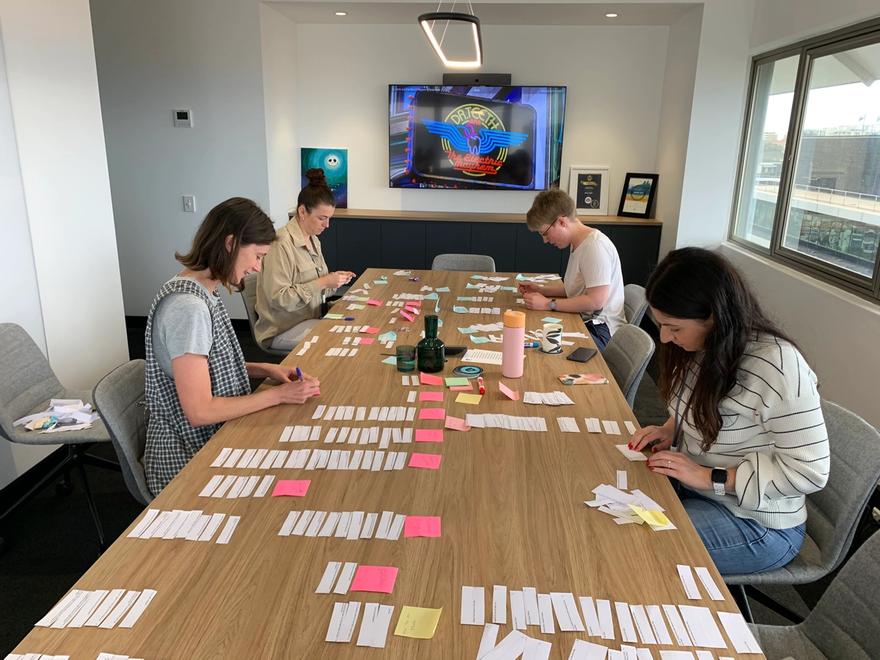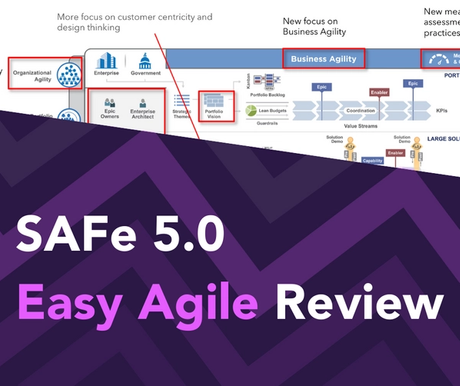Agile workflow
7 min read
Why large enterprises need SAFe not team-level Agile
Sun Dec 13 2020
Software development is incredibly dynamic and results-driven, with rapid innovation and technology changing all the time. So if you want to keep with it all – just like you do with the Kardashians – you need a flexible way of working that suits your organisation. If you’re struggling to work out how to coordinate multiple agile teams and scale agile transformations, Scaled Agile (SAFe) might be for you.
But what exactly do we mean by SAFe, and how can it help your enterprise work better together and more effectively serve your customers?
Read on as we discuss the differences between SAFe and agile and how you can use SAFe within larger companies. Below, we’ll cover why agile is still best for small teams and why enterprises should consider scaling up.
Want to empower your team to implement the Scaled Agile Framework (SAFe)?
Try Easy Agile Programs
What is SAFe?
Scaled agile framework, or SAFe, makes it easier for large enterprises to implement lean agile practices to improve their product and meet stakeholder requirements.
SAFe is a body of knowledge that has structured guidance on roles and responsibilities, work planning and work management, and core values.
SAFe is a combination of different agile practices, but it introduces one unique aspect: lean thinking.
Lean thinking should ensure no resources go to waste during the software development process. Trust us, your thrifty side will thank you. #ZeroWaste 💃🏼
SAFe also encourages people to apply systems thinking to three crucial areas: solutions to pain points, workflow management, and revenue streams.
Here, solutions refer to products, services, or systems that are delivered to the customer. Large solutions have several interconnected parts, so managers need a broader approach to see how they fit into the bigger picture.
People who follow the SAFe framework should think about the involved stakeholders and processes. If any organization wants to optimize how their teams work, they need to become cross-functional, remove silos, and make new working arrangements with suppliers and clients.
This can be a big change for many large companies with poor cross-functional collaboration.
The enterprise also has to define how value flows from concept to cash in the solution department value streams, which is a series of steps used to create value in SAFe. Plus, it's management’s job to maximize value flow across organizational as well as functional boundaries.
People often confuse agile to be the same as SAFe, but they have some key differences.
SAFe vs. agile: How do they differ?
Agile is a repetitive product development method that helps ensure the continuous delivery of tasks assigned. In other words, it's like Monica from Friends. She’s reliable and good at what she does.
In agile, cross-functional development teams work off a single backlog and break work into sprints, which means breaking down tasks into time-defined, smaller groups. This makes every person aware of what is expected of them, which, in turn, promotes productivity and increases the likelihood of better results.
That said, agile is mainly designed for smaller teams. Think 10 or fewer people. But if you’re an enterprise, don’t start sweating yet. In its simplest form SAFe is an agile framework for businesses that operate on an enterprise level. Enterprises are usually corporations that have hundreds, if not thousands, of employees and teams. So the number of people engaged is definitely larger.
The benefits are different as well.
Agile provides project managers, leaders, sponsors, and customers with various benefits, including faster turnaround time, resource wastage reduction, improved strategic focus on customer needs, better team collaboration, and feedback.
The biggest advantage of SAFe is it’s suited for enterprise problems. It keeps the size of the teams in mind as it helps increase productivity, make efficient project framework planning, and quicker codification of agile practices.
Having said that, SAFe and agile aren’t exactly on different planets.
The essential SAFe and agile core values are similar – but they aren’t exact. SAFe principles prioritize the following four:
- Alignment
- Transparency
- Built-in quality
- Program execution
Whereas, the core values of agile include:
- Customer collaboration over contract negotiation
- Faster response to change over a plan
- Working software of work comprehensive documentation
- Individuals and interactions related to processes and tool
Achieve team alignment at scale with
Easy Agile Programs
So, SAFe inspires lean-agile decision-making across large product management projects, while agile development promotes self-organizing, autonomous teams..
Organisations operating on a larger scale should consider scaling agile – which is exactly what SAFe is. Keep reading as we discuss this in more detail.
Why enterprises should consider scaling up from agile
Before discussing SAFe further, you have to understand what happens to relationships and communication when teams get larger.
The larger the team, the greater the number of relationships. Every new person adds some individual perspective to the team, but they can also increase overhead communication.
Let’s explain things from a mathematical point of view.
Imagine a team that consists of seven members. The total number of one-on-one relationships within the team is 21. But when you increase to nine members, the relationships between every individual becomes 36. Yep, that's the difference it can make! *mind blown*
How does SAFe serve larger teams better?
You may already be familiar with Scrum and Kanban – both of which are agile frameworks and are most effective at the individual team level in sectors primarily born out of software development, including DevOps and portfolio management.
It also means that adopting these perspectives when multiple teams are involved won’t be useful. #Frustration 😔 Although large-scale scrum is a possibility, product owners and product managers often look for other solutions.
SAFe goes beyond the team level, which, in turn, results in better alignment across teams and workload visibility. You're also able to make better predictions related to dynamic market conditions and ever-changing customer expectations.
*enter PI Planning or program increment planning*
PI Planning within SAFe can ensure better collaboration and decision-making between teams. Team leaders can decide on features to work on next, identify dependencies, and develop a new plan for program increment in a much more effective and efficient manner.
So teams work with each other and not against. #Win 🥳
A full SAFe adoption can solve enterprise pain points and boost competencies
Keep reading as we discuss how SAFe solves large enterprise pain points in a way agile alone cannot.
Make processes configurable and scalable
Implementing SAFe for larger teams isn’t difficult – all you need to do is add a layer to the process map. And take your patience levels up a few notches. These changes can help the team visualize how the different teams can continue to work together harmoniously after any change.
In other words, business agility won't have to be compromised.
The Agile Release Train (ART)
An ART enables Scrum and Lean teams to experience the benefits of proper process alignment that the Program and Portfolio processes expand upon as the team starts to grow.
Clearly defined processes and roles
It’s normal for teams to face problems, but with SAFe, they'll get a better idea of how to solve them by improving their thought processes and utilizing specific tools.
What's more, the SAFe website has an in-depth explanation of concepts along with process maps that serve as visual aids to understand the said concepts and processes.
Scaled Agile improves team collaboration
SAFe helps large organizations carry out large-scale, mission intensive projects better. The combination of existing lean and agile principles can play a very positive role in facilitating better communication and control between multiple teams.
As a proud Scaled Agile Platform Partner, Easy Agile Programs enables Release Train Engineers and Program Managers to effectively manage programs at a ‘team-of-teams’ level to deliver alignment at scale.
If you want to learn more about agile teams and frameworks, we have plenty of guidance that can help you ensure better results for your organization.

